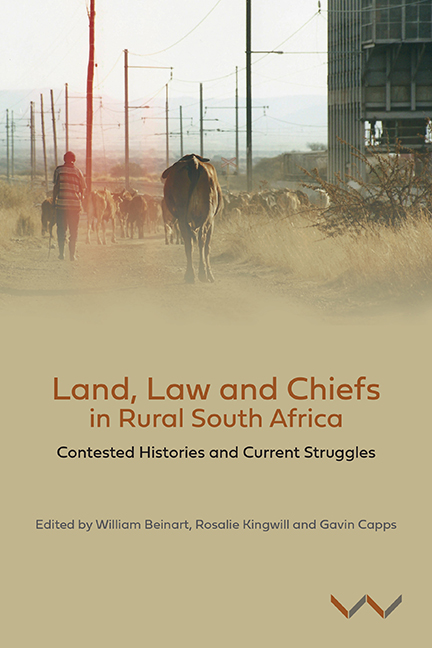Book contents
- Frontmatter
- Contents
- Maps
- Acronyms and Abbreviations
- Preface
- Introduction Land, Law and Chiefs: Contested Histories and Current Struggles
- Chapter 1 Constitutional Court Judgments, Customary Law and Democratisation in South Africa
- Chapter 2 Was ‘Living Customary Law’ There All Along?
- Chapter 3 When Custom Divides ‘Community’: Legal Battles over Platinum in North West Province
- Chapter 4 Chiefs, Mines and the State in the Platinum Belt: The Bapo-ba-Mogale Traditional Community and Lonmin
- Chapter 5 Mining, Graves and Dispossession in Mpumalanga
- Chapter 6 The Abuse of Interdicts by Traditional Leaders in South Africa
- Chapter 7 Resisting the Imposition of Ubukhosi: Contested Authority-Making in the Former Ciskei
- Chapter 8 Black Landlords, Their Tenants and the Native Administration Act of 1927
- Chapter 9 Customary Law and Landownership in the Eastern Cape
- Chapter 10 A History of Communal Property Associations in South Africa
- Chapter 11 ‘This is Business Land’: The Hlolweni Land Claim, 1983–2016
- Chapter 12 Restitution and Land Rights in the Eastern Cape: The Hlolweni, Mgungundlovu and Xolobeni Cases
- Contributors
- Index
Chapter 2 - Was ‘Living Customary Law’ There All Along?
Published online by Cambridge University Press: 15 June 2021
- Frontmatter
- Contents
- Maps
- Acronyms and Abbreviations
- Preface
- Introduction Land, Law and Chiefs: Contested Histories and Current Struggles
- Chapter 1 Constitutional Court Judgments, Customary Law and Democratisation in South Africa
- Chapter 2 Was ‘Living Customary Law’ There All Along?
- Chapter 3 When Custom Divides ‘Community’: Legal Battles over Platinum in North West Province
- Chapter 4 Chiefs, Mines and the State in the Platinum Belt: The Bapo-ba-Mogale Traditional Community and Lonmin
- Chapter 5 Mining, Graves and Dispossession in Mpumalanga
- Chapter 6 The Abuse of Interdicts by Traditional Leaders in South Africa
- Chapter 7 Resisting the Imposition of Ubukhosi: Contested Authority-Making in the Former Ciskei
- Chapter 8 Black Landlords, Their Tenants and the Native Administration Act of 1927
- Chapter 9 Customary Law and Landownership in the Eastern Cape
- Chapter 10 A History of Communal Property Associations in South Africa
- Chapter 11 ‘This is Business Land’: The Hlolweni Land Claim, 1983–2016
- Chapter 12 Restitution and Land Rights in the Eastern Cape: The Hlolweni, Mgungundlovu and Xolobeni Cases
- Contributors
- Index
Summary
In recent years, South African constitutional jurisprudence has shifted to incorporate and develop the notion of ‘living customary law’ (see Budlender in this volume). Moreover, the concept has circulated outside the courts and legal profession, with the potential to reframe scholarly and policy discourses on struggles over land and other natural resources. This chapter examines the relationship between legal and analytic terminologies through a reflexive reading of the reframing of my own work as evidence of ‘customary law rights’ in the context of a 2012 trial. In doing so it engages a set of questions, the first of which forms the title of this chapter: was ‘living customary law’ there all along?
I conducted ethnographic fieldwork in Hobeni, near the coast of the former Transkei, Eastern Cape, in 1998–1999 and returned for follow-up research in 2009– 2011. My findings predominantly revealed continuities in the practices around land tenure. Why should this now be labelled ‘living customary law’? Had I failed to recognise it, or to name it correctly? If it had been possible to think about this material without reference to the concept of ‘living customary law’, what would be gained, or lost, or changed – analytically, legally or politically – by deploying the concept?
I was engaged as an expert witness in a 2012 court case (Gongqose) involving three fishermen arrested inside Dwesa-Cwebe Nature Reserve. During the case I presented material written a decade earlier, prior to the ‘living customary law’ jurisprudence, from my 20 months of research in Hobeni. This was one of the seven communities adjoining the reserve and my earlier visit coincided with negotiations regarding a land restitution claim on the reserve. The court eventually found, legally speaking, that a customary system of resource regulation existed, thereby providing grounds for a series of appeals that culminated in a successful case in the Supreme Court of Appeal in May 2018.
In the course of the trial and the subsequent appeals, and in the work of my fellow expert witness, Jackie Sunde, my earlier work on land tenure was cited as evidence of customary law. In reflecting on references to my work in Sunde's dissertation (2014), I came to look back at how – and whether – I had engaged the language of ‘customary law.’
- Type
- Chapter
- Information
- Land, Law and Chiefs in Rural South AfricaContested histories and current struggles, pp. 35 - 59Publisher: Wits University PressPrint publication year: 2021

